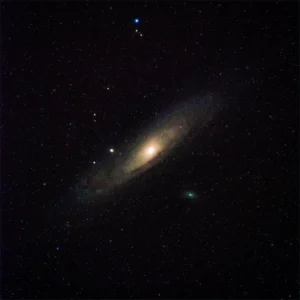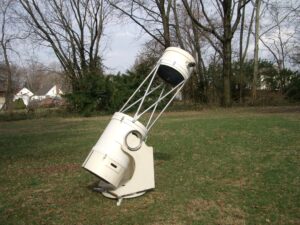Part 2: Astronomy Observing Basics
Part 2: Astronomy Observing Basics
Astronomy beckons both novice stargazers and seasoned observers to explore the mysteries of the universe. Any beginner wanting to fully appreciate the wonders that lie beyond our atmosphere may feel intimidated by the diverse types of equipment that seasoned stargazers use. When venturing into the realm of astronomy, choosing the right equipment can make the difference between a captivating night sky exploration and a frustrating endeavor.
The good news is you don’t need any special gear to get started, as there are a great number of objects to look for just with the naked eye. Learning the constellations alone is an essential skill to improve your observational abilities, and this is done without the use of any optical equipment. Many enthusiasts in astronomy aspire to observe fainter deep sky objects, along with objects like the moons of Jupiter and Saturn. For these fainter celestial bodies, the use of an optical system becomes essential.

The term “optical system” is used instead of the word “telescope” because one of the most budget-friendly and effective tools for beginners is a reliable pair of binoculars. Binocular astronomy is a cost-effective way to enjoy the hobby without the need to invest several hundred dollars on a telescope.
There are many great examples of binoculars made specifically for astronomy such as this or this, but don’t ignore the dusty pair of birding binoculars you have stored in your closet. As long as they produce a quality image, any pair of binoculars are a great step-up from observing with the unaided eye. Binoculars will allow you to collect more light and thus see fainter objects with ease. It may be a bit awkward at first since you will have to lean back much further than you usually would to spot terrestrial targets, but with some practice you will soon be finding those elusive nebulae and star clusters.
If you are looking to purchase a telescope, there are a few pitfalls to avoid. Notably, try to avoid products astronomers affectionately call “hobby killers”. These scopes are often marketed as cheap deals that are suitable for children or novices getting into the hobby. You may have encountered one in your past if you were ever gifted a telescope as a child.
Hobby killers are characterized by shoddy craftsmanship, poor optics, and usually have flimsy, shaky tripods, and hard-to-adjust mounts. While there is no definite bottom line for price points, be wary when considering any telescope under the $250 mark. Some notable exceptions to this rule are this tabletop reflector from Orion or this one from Astronomers Without Borders.
Be careful not to overshoot your budget and buy top-of-the-line equipment with all the bells and whistles. Buying a complex telescope system may end up being overly complicated for the beginner and may discourage them from continuing with the hobby.
Many astronomers will attest that one of the best kinds of telescope for beginners is the Dobsonian. This type of telescope system is a simple reflector (using a mirror to collect light) called a Newtonian on an Altitude-Azimuth (Alt-Az) mount, or one that moves in the right-left and up-down directions. A Dobsonian is much simpler and more intuitive than telescopes that use more complex equatorial mounts.
Dobsonians are easy to transport and set up, and most do not require power to run.

Dobsonian Telescope (Truss Tube Design)
While a Dobsonian telescopes will lack any computer-guided features, it is often the best ‘bang for your buck’ for beginner telescopes, and its manual nature will help you improve your object location skills.
There are many quality telescope brands to choose from, here are a few of them:
Consider exploring the second-hand market. You can find some great deals on second-hand marketplaces like Craigslist or Facebook Marketplace. Astronomers often take pride in and carefully maintain their equipment.
Other Astronomy Equipment
In addition to binoculars or a telescope, there are a few things that can make your star-gazing easier and more enjoyable.
- For ease of navigating your observing site without upsetting your night-vision, a red flashlight can be incredibly useful. Red flashlights can be found inexpensively online, or you can make your own out of a normal flashlight and translucent red tape or red cellophane.
- For easily pointing out areas of interest in the sky to others, a laser pointer can be an invaluable tool. Many astronomers prefer a green laser pointer, as green light is the most easily seen color by the human eye.
Safety Note: Laser pointers can be dangerous. Extreme caution must always be used when using a laser pointer to ensure that it is never pointed at someone’s eyes, reflective surface, or at an aircraft.
- A compass can be useful for orienting yourself in a new area and for locating night-sky objects.
- A star chart or planisphere is a low-tech way to find the constellations at any time of year. Rotate the disc to reflect your time and date, hold the planisphere overhead with the cardinal directions pointed in the correct orientation. The planisphere will show you where you can see the constellations visible to you, depending upon your latitude.
- An astronomy app like those mentioned in the previous post can be instrumental to finding fainter objects.
When looking for an object with binoculars, telescope, or the unaided eye, make note of constellations near to the object. Make a mental map of the brighter stars closest to the target. Often, you can draw a direct line with two stars which points directly (or close) to the location.
Any quality telescope will have a finder such as a spotter scope, red dot sight, or telrad sight. Use this first to line up your target before looking through the eyepiece. You may need to align your finder at the beginning of the night. To do so, center your telescope on a bright star and adjust your finder scope with the adjustment screws at its base.

Aaron Bailey adjusts a telescope outfitted with a spotter scope sight during a Family Star Party at Space Foundation Discovery Center
If you are observing outside the warm summer months, temperatures will inevitably drop. Make sure you bring extra layers of warm clothing. A warm beverage and chemical hand warmers are a good investment as well.
The right astronomy equipment can turn a mediocre night of stargazing into a magical one. The best gear you can buy is the type that gets you outside under the stars more often. Sometimes, all you need is a warm blanket and hot beverage to bask in the beauty of the cosmos.
Aaron Bailey is an educator with a background in Astronomy and Physics and writes lessons and designs interactive STEM curricula for many Space Foundation programs. He joined the team in September of 2021. He is responsible for the Family Star Party and is an active member of the Colorado Springs Astronomical Society (CSASTRO). He began the Discovery Center Astronomy Club to bring together STEAM-loving teens to discuss astronomy and space science.
If you have additional questions, please reach out to [email protected].
